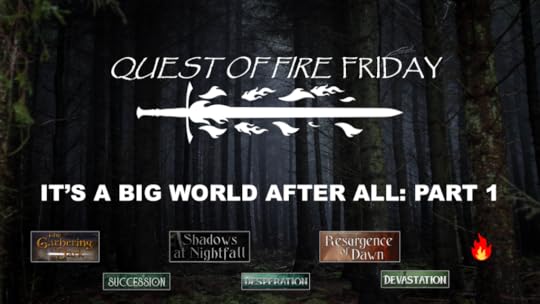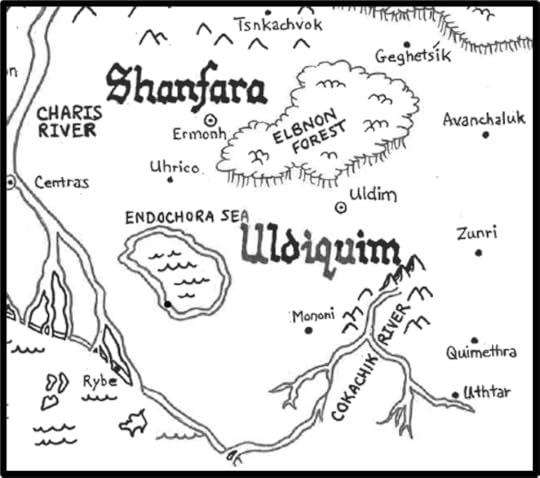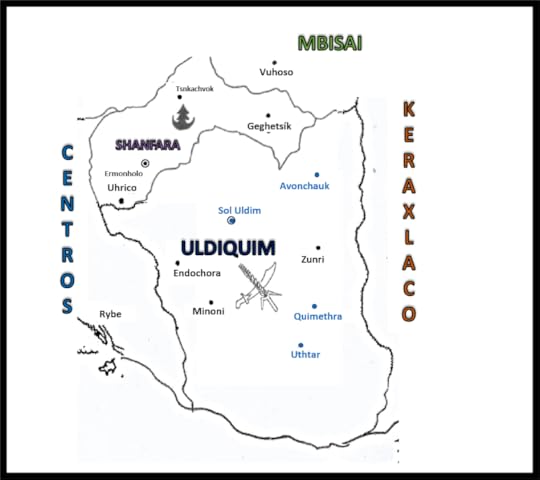QUEST OF FIRE FRIDAY: IT’S A BIG WORLD AFTER ALL – PART 1

Hello there!
Welcome to another Quest of Fire Friday! This is the first in a series in which I would like to share with you some extended details on some of the more recently revealed localities in Quest of Fire. First up is the somewhat ignominious Uldiquim.
OVERVIEW
Uldiquim was first mentioned in Resurgence of Dawn. It’s a relatively large country that came to exist in the Modern Era through the conquest of Quimethra by Uldi. Uldiquim or the Uldiqui Confederacy are the monikers Ecthelish merchants labeled it with but to the ruling Uldi class the nation is the Grand Khanate of Uldi. It’s a landlocked nation bordered by Centros to the West and south, Keraxlaco to the east and south, and Shanfara and Mbisai to the north. It is mountainous in the southern Quimethran area with the Cokachik River, the sweeping plateaus and table land across the north central country with the Elbanon Forest as a buffer with Shanfara and the Endochora Sea an effectively separating it from Centros’s heartlands. There is a semi-arid region located around Zunri. The country is divided into satrapies and as a whole belongs to the Far Southern Realm.
ANCIENT ERA:
Some of the earliest cities of the Lowlands were built in the lands now comprising Uldiquim. During the Ancient Era, a collection of tribes united under a warlord named Reznal to create the city state of Lugaluk. Over the centuries Lugaluk exerted enormous influence over the area that eventually became Uldi. Centuries of rule came to an end after a series of famines and palace coups as the eponymous Uldi people group came to dominate the region and overtook Lugaluk shortly before the start of the Middle Era.
To the south, Quimethra followed a similar path early on, except that it faced waves of invasions from the sea as colonists from Theratos continuously clashed with the local Quidar population. Eventually a Theraton conqueror, Methra, invaded and overtook all of the Quidar’s lands and claimed nearly half of the Uldi lands, placing the initial stressors on Lugaluk that led to its fall centuries later, before his death. His top general succeeded him and renamed the land Quimethra in honor of his wanax (ruler). Thereafter the Quidar and Theraton colonists intermarried and by the end of the Ancient Era there was only one discernible people.
MIDDLE ERA:
Uldi in its more arid lands developed a nomadic modality and a harsh outlook on life. Slavery was quickly introduced into Lugaluk and it persisted into Uldi’s establishment. They did have the peculiar breed of goats native to the Elbnon Forest to shear for trade and for their horns, which were considered a rare and valued prize for their size and unique notes they could produce. Sounding like a strong breeze on a mountain slope or a mewling kitten depending on how it was used.

By contrast, the better soil of Quimethra allowed them to thrive and with the Theraton influences they pursued art, music, poetry, and led gentler, quieter lives. By the end of the Middle Era, Quimethra had adopted a direct democracy with each major civic center in its lands casting votes from the land holding population.
Uldi saw the wealth and ease of Quimethra and being in the throes of yet another famine, launched a brutal war against Quimethra. Though more prosperous, Uldi was more experienced in war and brought to bear trebuchets imported from Jhi that tore apart the impressive stone strongholds of Quimethra. The war ended at the Battle of Cokachik River with the armies of Quimethra suing for peace with the Uldi and willingly surrendering all of the Knights of Light and other undesirables to the Uldi. Though outsiders view them as one people and the Quimethran descendants have thoroughly integrated and attempted to ingratiate themselves to their more powerful Uldi allies. Even so, the Uldi were quick from the outset to establish themselves as the ruling class and Quimethrans as servants.
MODERN ERA:

Through trade established with Rehalcy during the closing years of the Middle Era, Uldiquim became aware of Monarch Ilyron and the forbidden legends of Tislatna. Especially in the northern lands that belonged to the Uldi, filtered through the sympathetic tales of the Rehalcy, Monarch Ilyron became a tragic antihero figure and was celebrated as a model leader. Cults of Tislatnean practice rose up, which stood at odds with the Quimethra people’s largely Knight of Light population. This led to a brutal campaign to cleanse Knights of Light from Quimethra and eventually the Uldi preferring to enslave Knights of Light from neighboring countries like Shanfara, Mbisai, and nearby Yusbilsi. Growing fat and cruel off the backs of slaves and the fruits of Quimethra, the Uldiqui were eager to join the Rehalcyon Empire’s Confederacy, especially when the Wernstrum crime family insinuated that Monarch Ilyron had returned thanks to dark incantations and that he would lead the Confederacy of Nations to conquer the Lowlands and reestablish Tisltana, bringing with it untold powers and wealth.
NOTABLE LOCATIONS:
Uthtar – featured in Resurgence of Dawn, the mansion located at Uthtarf was once a manor house of a local contingent of Quimethran Knights of Light. However, an Uldi warlord turned it into his personal residence and there conducted all manner of torturous executions and purges filling a cistern adjacent to the mansion with the bodies of his victims. With such a dark past, the location eventually became a place of meeting for members of Tislatnean cults eager to see Monarch Ilyron return and oblivious to the dark powers they were opening themselves to be influenced by.
Dragone Petra – a monumental statue that stands sixty-five feet tall. It was cut from the basalt of the Dark Hollow Formation near Zunri. Over 250 slaves were used to haul it from the site of its quarry and sculpting to Sol Uldim. The enormous statue was placed atop a square platform with elevated chevron pointing in the four cardinal directions. Each chevron has a fiery pit of flames within kept burning constantly. Looming over the city for nearly two hundred fifty years, it was utterly destroyed in an earthquake that took place soon after a sheep with a crown and wig was sacrificed before it, an effigy representing the High King of All Realms and his Knights of Light.
Afterwards no one could approach the square, because the quake exposed an underground seam of coal or oil. The fire from the burning chevrons ignited it and no one has been able to extinguish the flames for the centuries since its destruction.
The Ziggurat of Lugaluk – Ruins of an ancient era structure believed to have been Reznal’s palace before it was converted into a tomb for him, the harem of wives he kept, and one hundred slaves and servants. A small honor guard were all also embalmed and placed within the structure. Old myths tell of subsequent rulers of Lugaluk traveling to its top to receive from it the power to rule all they could see in every direction. In later years, the myths appeared to be taken seriously as a series of additions not part of the original were built onto it to raise it ever higher for a broader vantage point. A few smaller ziggurats of similar design dot the cliffs of Uldiquim’s Avonchauk region.
Quimethran Tunnels- In order to escape the vicious purges and wars of the Uldi, Quimethran Knights of Light built tunnels beneath the great civic centers of Quimethra that lead out into the wilderness. Some simply dug into soft stone of Quimethra others formed from elaborately stone worked passageways that included secret safe rooms to help with funneling Knights to safety elsewhere, such as in neighboring Keraxlaco and Vov Hilan. Which had a strong impact on both nation’s cultures and ethos for centuries.



